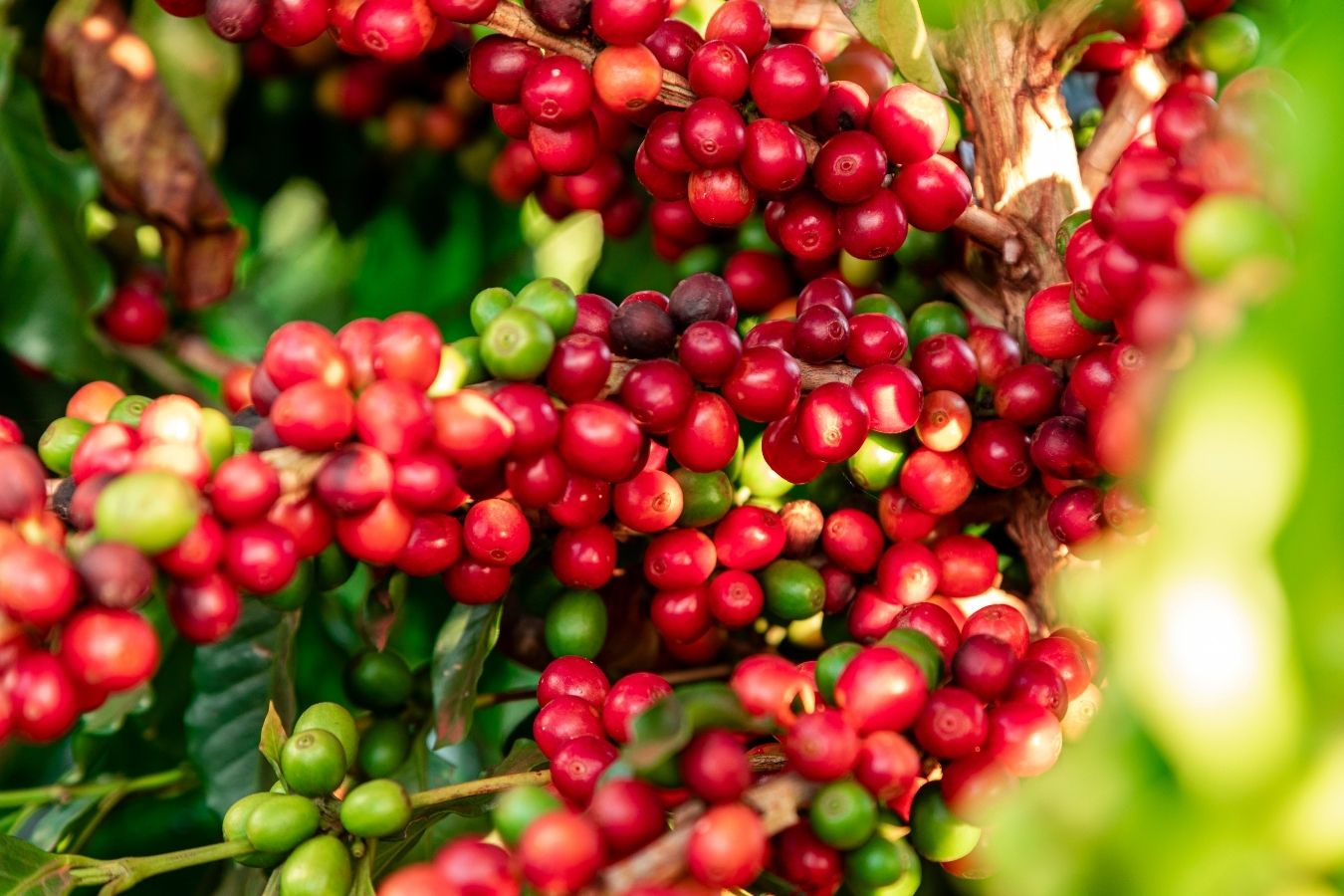
Coffee Basics Overview For You: Coffee is a familiar drink in any part of the world. To help understand more about coffee, Helena Coffee Vietnam has compiled and summarized knowledge related to coffee in the following article. This knowledge helps you have an overview, from which there is a basis for further research. Despite many efforts, there are still shortcomings. Helena Coffee Vietnam will supplement and update regularly.
1. Legend Of The Coffee Tree
There is an interesting legend about the coffee tree as follows. While feeding his sheep once, a shepherd boy named Kaldi observed that the sheep were eating strange red fruits that suddenly jumped with unusual joy. He tasted this peculiar fruit and suddenly felt highly refreshed and full of energy. Then he informed the monks. At first thought, the forbidden fruit brought the devil decided to burn this seed. However, the scent released from unknown sources made them want to taste it when burned. Indeed, their spirits were exceedingly refreshing. They decided to make it a drink before each ceremony.
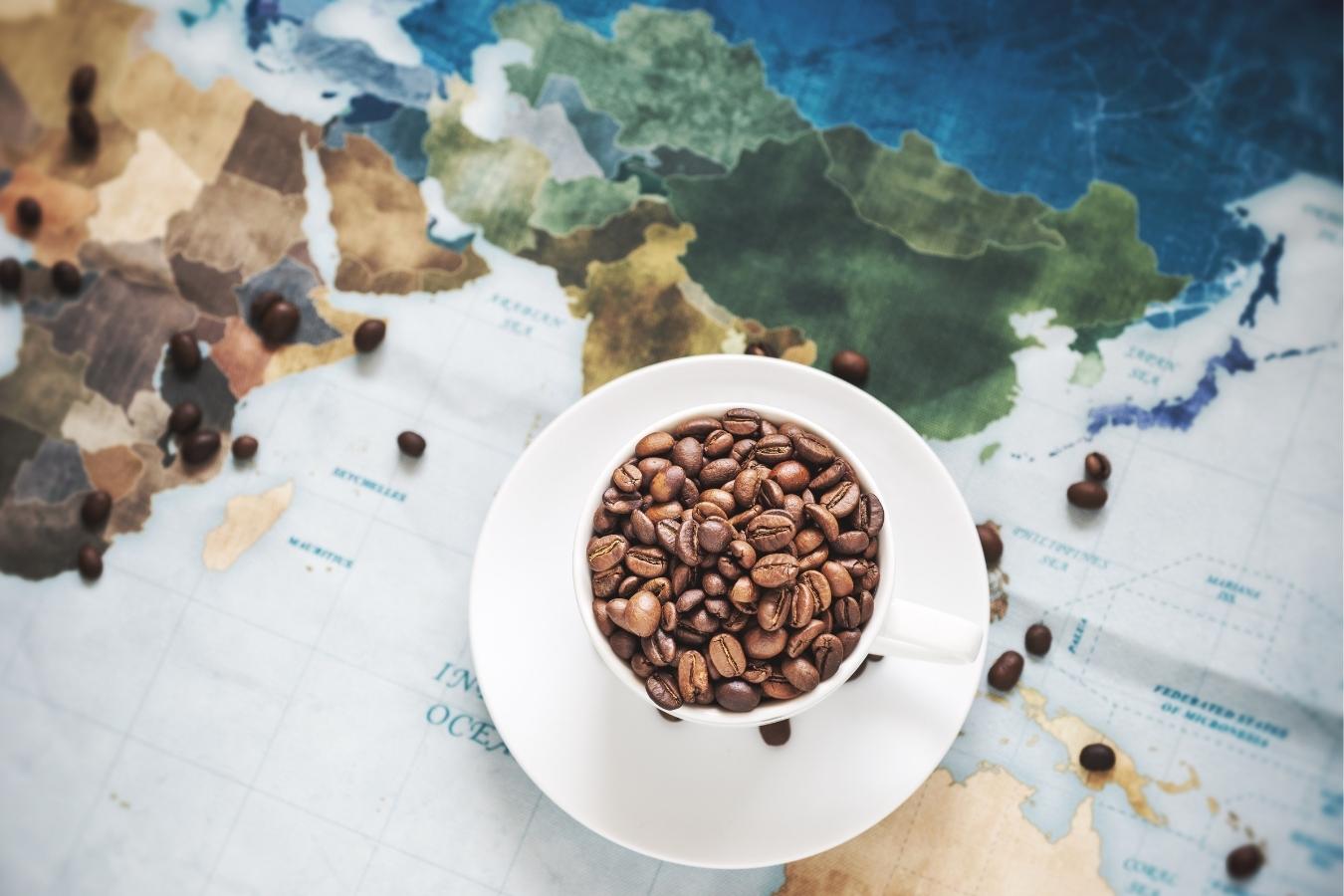
However, that is just a legend. The coffee plant originated in Ethiopia (formerly known as Kaffa). Enslaved people captured from Ethiopia to Egypt brought this fruit with them. They soon became a trendy Egyptian drink.
In the 18th century, the first Dutch people brought coffee outside Egypt and planted it in Martinique. Then the French and Brazilians also brought this fruit back to their homeland. That was the first step for coffee trees to be produced worldwide.
2. The Bean Coffee Belt
Coffee trees can be grown in many places around the world. However, there are only areas within the coffee belt; where soil, altitude, climate, and weather are met, new coffee trees grow, develop well, and produce quality coffee beans with rich flavor.
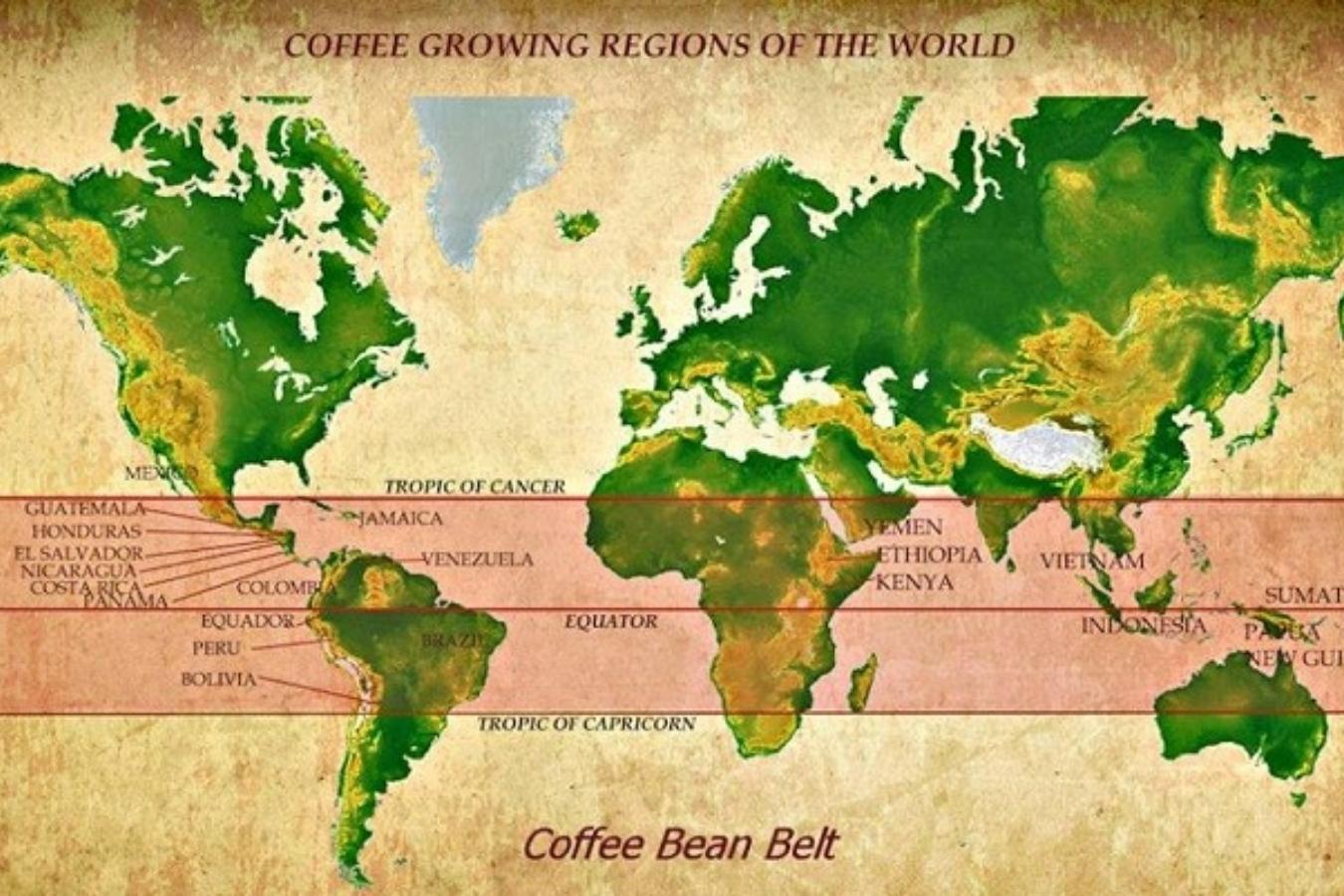
The coffee belt is located along the equator, between the 23rd latitude north and the 23rd parallel south. The lands within this boundary, combined with an altitude of 500-2,000 meters above sea level, rich soils, hot and humid tropical climate, and suitable rainfall, are ideal for growing coffee trees. And develop.
3. Coffee Growing Countries In The World
About 75 countries are in the coffee belt, but only 60 countries can grow coffee. In there:
- Africa is the cradle of coffee. This land has a variety of varieties and species, where unique and valuable genetic resources are preserved. Coffee-growing countries in Africa can be mentioned as Ethiopia, Uganda, Kenya, Tanzania, etc.

- America is considered the world coffee farm. The coffee has a mellow and balanced taste, floral, orange, lemon, and light body. Coffee growing and exporting countries: Brazil, Colombia, Honduras, Mexico, …
- Asia has only about eight coffee-growing countries, including Vietnam, Indonesia, India, China, and Yemen,… Asia’s coffee flavor has a characteristic earthy smell, sweet taste, chocolate flavor, and a bit of bitterness. Physically bold.
4. Coffee Flavor By Altitude
Altitude is a prerequisite factor affecting coffee quality. Altitude is as important as the seed source itself. The higher the coffee tree is grown, the longer the growth cycle is, and the slower the accumulation of nutrients in the beans, resulting in a richer flavor and firmer and heavier beans.

Of course, altitude, soil quality, rainfall, climate, etc., also determine the quality of coffee beans. However, the properties of coffee beans change with height as follows:
- 600m: Coffee usually has a strong, bitter, and simple taste at this altitude.
- 600 – 760m: Coffee has a light, earthy flavor at this altitude.
- 760 – 910m: The coffee starts to have a sweet, mellow taste.
- 910 – 1200m: At this height, coffee has characteristics of citrus, chocolate, and vanilla.
- 1200 – 1600m: Coffee has a rich flavor, fruit flavor, and floral flavor.
5. Coffee Is Imported Into Vietnam.
In 1857, the French brought the coffee variety Tea (Arabica) from Bourbon to grow in the northern and central provinces such as Xuan Mai, Son Tay, Quang Tri, Bo Trach, etc. However, the yield of coffee was in the regions. This is very low, only about 400 – 500 kg / 1 hectare. After that, they brought coffee seeds to plant in many places and set up plantations in the southern provinces and the Central Highlands.
In addition, new types of coffee such as Robusta (Vai coffee) and Mitcharichia (Jackfruit coffee) were also planted for trial. Since then, coffee has become the most popular industrial crop in Vietnam.
6. Coffee Growing Areas In Vietnam
That day, the French experimented with coffee at plantations across the country. Areas with a favorable climate for coffee to grow have been expanded, and areas with low yields will be eliminated. At the same time, they also found a suitable planting place for each coffee variety.
There are many coffee-growing areas in Vietnam, such as Thanh Hoa, Nghe An, Ha Tinh, Central Highlands, and the South. However, in terms of climatic conditions, the provinces of the Central Highlands are the most suitable for coffee trees to grow. Therefore, this plant is increased a lot here. Coffee plantations with very high productivity and excellent coffee quality were born, especially in Dak Lak and Gia Lai.
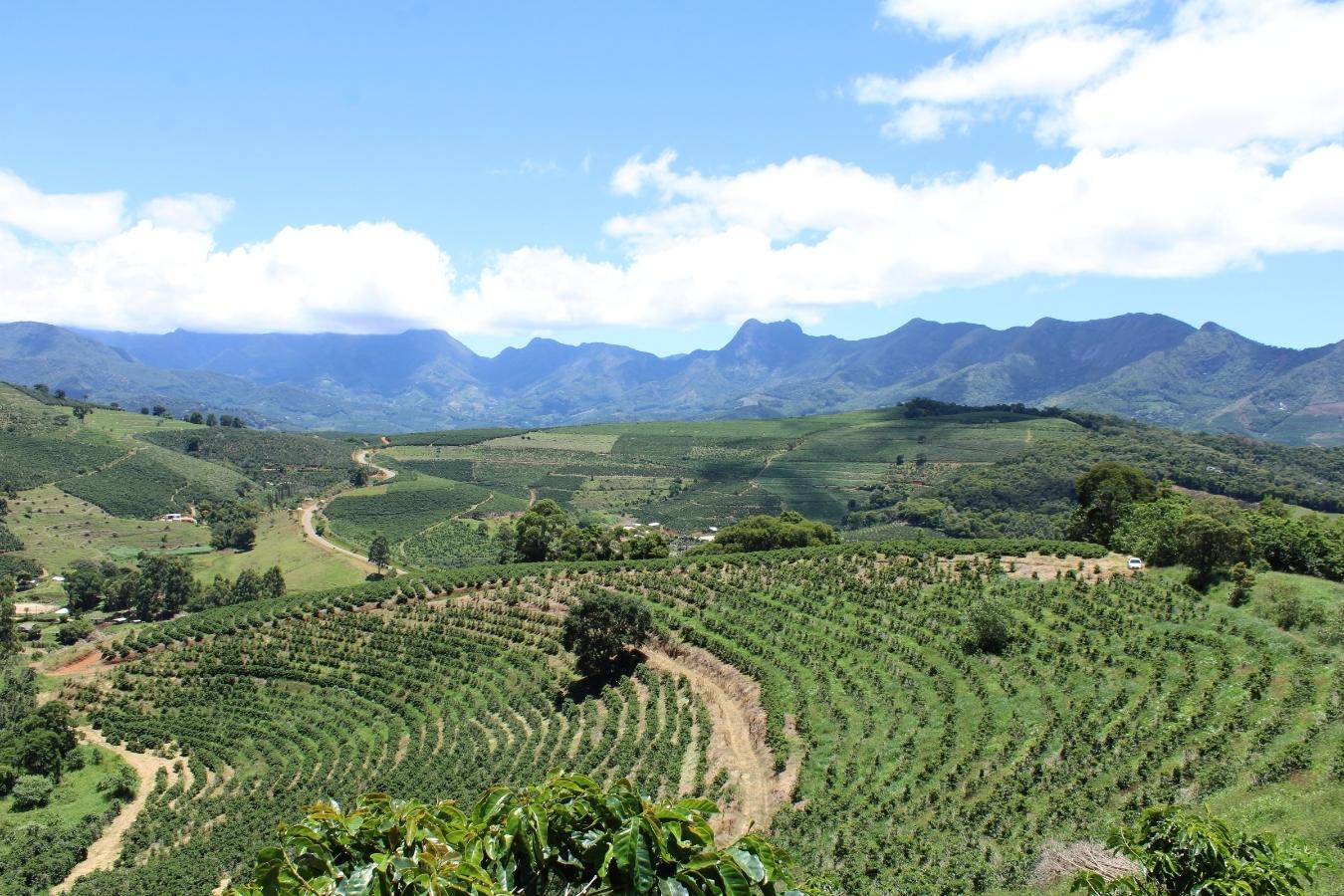
However, with the highest quality known, the best coffee varieties often come from Da Lat and Lam Dong. The altitude, temperature, water, and light conditions here are incredibly favorable for top plants like Moka and Bourbon to live.
7. Famous Coffee Lines In Vietnam
The tropical monsoon climate in Vietnam is very suitable for coffee trees to grow, especially high-quality coffees such as Arabica, Robusta, and Cherry.
Arabica coffee
Arabica belongs to the family Rubiaceae, genus Coffea, and in Vietnamese, it is called “coffee” because of its characteristics of tiny leaves and low stems like tea trees in Vietnam. Arabica is native to southwestern Ethiopia. Then followed the French to Vietnam. This is the first coffee grown in our country.
Arabica has many different varieties in the coffee family, and almost all of them are the best coffees. Some names can be mentioned, such as Typica, Bourbon, Caturra, Catuai, Catimor, and Moka.
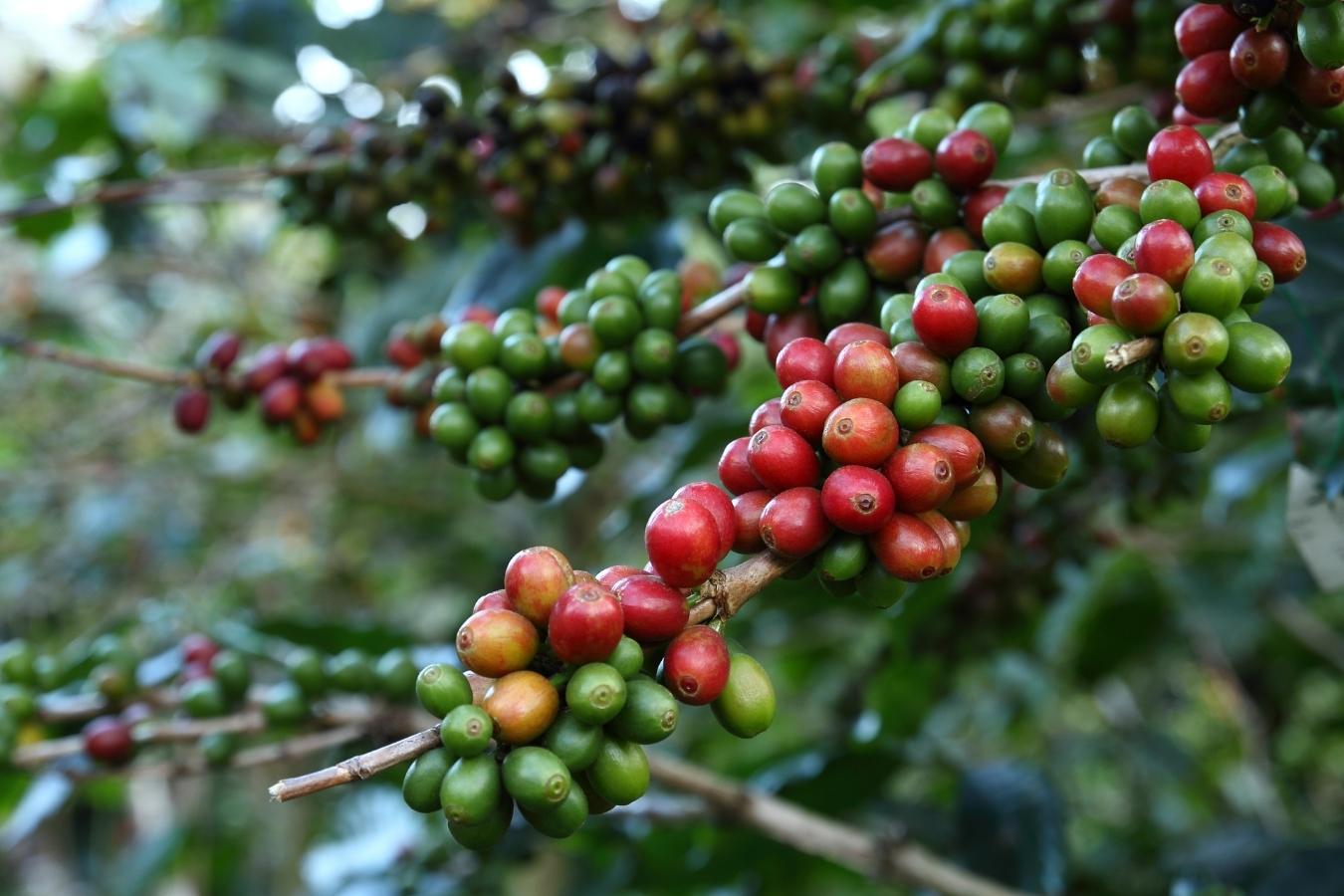
Robusta Coffee
Up to 39% of coffee production globally is Robusta ( 1 ). The trunk of Robusta is taller and more branched, and its leaves are more significant than that of Arabica.
The taste of Robusta is not as appreciated as Arabica. However, the outstanding feature of this coffee variety is its very high caffeine content, accounting for about 2-4% of coffee beans, while Arabica only has 1-2.5%.

Liberica Coffee
also known as Jackfruit coffee originates from Ubangui Chari, near the world’s largest desert, the Sahara. Therefore, this plant has the characteristics of quite tall, large stem and leaves to store water and can grow well in dry climates.
The fruit of Chari is more significant than other varieties, but the yield is not high. In terms of taste, it is not as appreciated as Arabica or Robusta, so it is grown minimal today in our country.
In addition to the above coffee varieties, the market also mentions a lot of mutant Peaberry lines, bringing both the flavors of Arabica and Robusta coffee.
8. Coffee Flowers
Coffee flowers only germinate under low-temperature conditions or are provided with water after a dry period lasting about 2 to 3 months. Usually, the seasons with a hot climate alternating with rain after a few months will help the coffee flowers bloom at the right time, giving a higher yield.
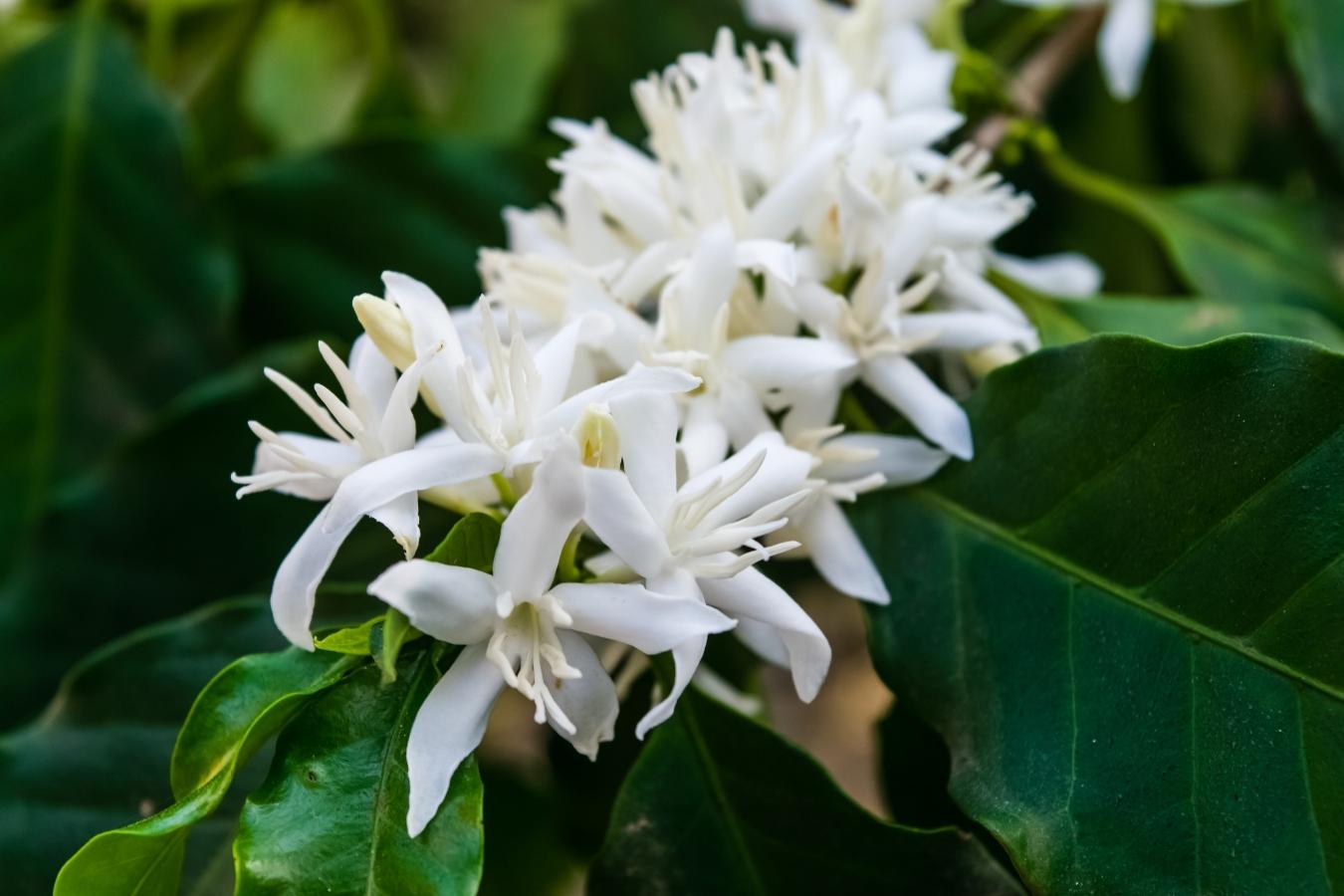
Knowing the blooming principle of coffee flowers, growers will take measures to provide appropriate water and nutrients to increase the crop’s yield. However, it should be noted to avoid bad weather and prolonged rain, especially frost, which will cause coffee flowers to rot, significantly reducing gain.
9. Structure And Composition Of Coffee Berries
Structure of coffee fruit
In a coffee fruit, there are six main parts: stem, pod, fleshy skin, husk, silk skin, and kernel, also known as the coffee bean.
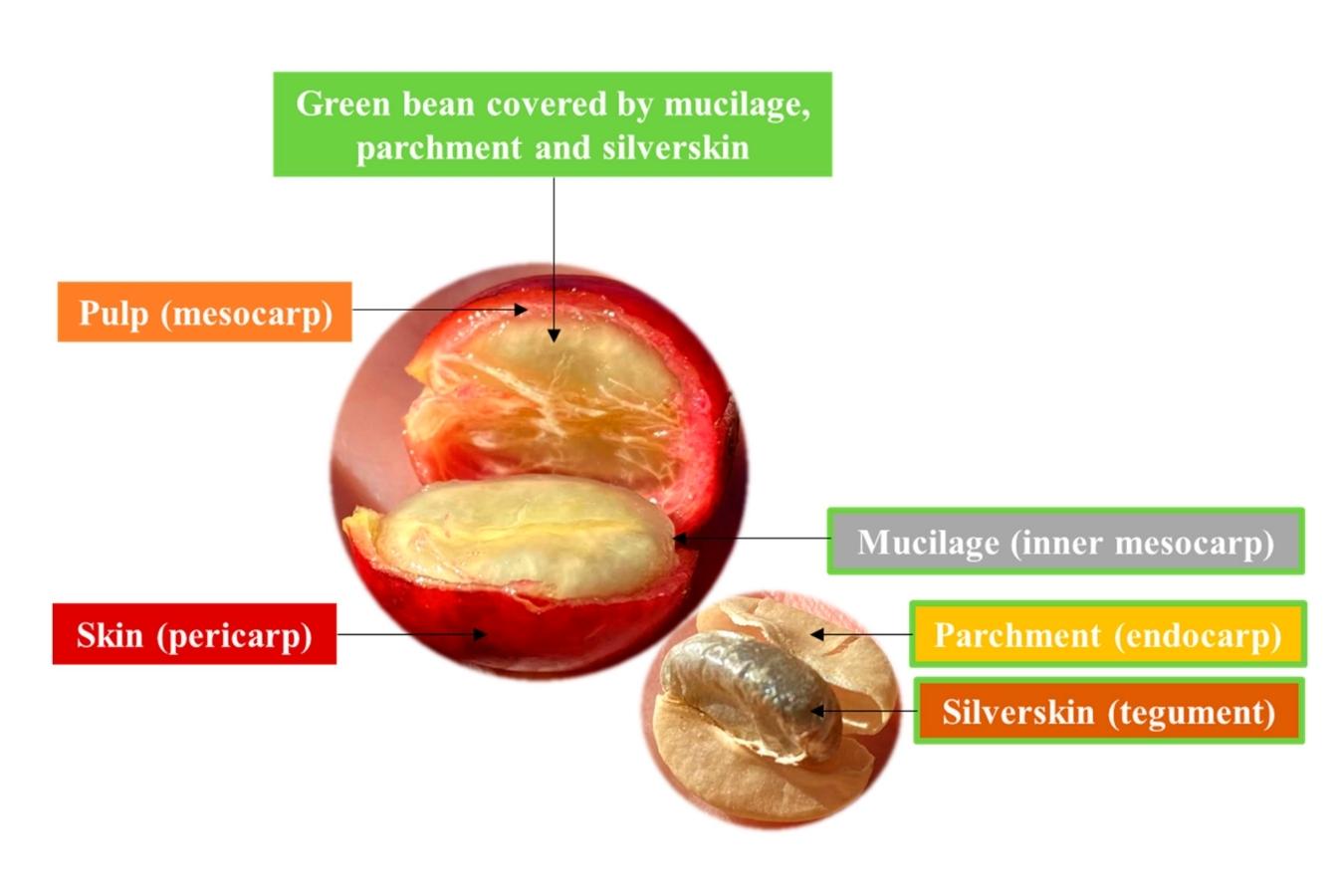
Coffee stalks
As the link between the fruit and the branch, the coffee stalk needs to be supple. This helps the coffee cherries not fall off due to natural external influences but must be crunchy for easy picking.
Peel
This is the outermost layer of the coffee fruit, which covers and protects the inside. When unripe, the coffee pods will be green, and when ripe, they will gradually turn red or yellow, depending on the coffee variety. The rind of Arabica varieties will be softer and smaller than that of Robusta and Chari.
Meat shell
The fleshy pods of the coffee have a mildly sweet, edible taste. In the way weasel coffee is made, the weasel will eat and absorb the flesh and release the kernel. The skin of Arabica has the sweetest and softest taste, while the Chari coffee has the thicker skin of the whole.

Rice husk part
After being dried, this is a relatively rigid shell to protect the coffee bean. After harvesting coffee, people will remove the outer shell. The flesh and slime part, only the husk and seeds inside. This husk is also released when processing and can be used as fuel and excellent compost.
Silk shell
The silk shell is the fragile and soft part surrounding the coffee bean. Each type of coffee has a different silk color. Accordingly, the skin of Arabica coffee is white, Robusta coffee is light brown, and the silk skin of Chari coffee is pale yellow.
Coffee filling
This is the component that creates value for the coffee tree. The coffee bean is divided into two parts: the rigid outer part consists of small cells containing oil, and the inner part has large and relatively soft cells. Except for cases like coffee with only one kernel, or rarely 3, most coffee beans have two equal parts.
Chemical composition of coffee berries
In a whole coffee fruit, there will be many different ingredients. Each ingredient is essential to creating the flavor of the coffee.
Peel
In the rind of the coffee, fruit contains a lot of anthocyanins, so when ripe, the fruit is usually red. In addition, the skin also contains many substances such as caffeine, alkaloids, tannins, and many other enzymes.
Meat shell
The fleshy crust contains mainly viscous substances and soft cells. This part includes a lot of sugar that makes the coffee taste sweet. Besides, it is a substance that supports the fermentation process of Pectinase, which makes the taste of the coffee bean more delicious.
Rice husks
Because it is wrapped right outside the kernel, the husk also inherits a significant amount of caffeine, up to 0.4% of the weight of the coffee fruit.
Coffee filling
In fully ripe coffee beans, water accounts for 10 – 12%, then 10 – 13% Lipid, 9 – 11% Protein, 5 – 10% sugar, and 3-5% starch. Each type of coffee has a different chemical composition that creates a unique flavor. In addition, if the processing is optimized, it also helps to improve the quality a lot.
Characteristics of substances in coffee beans
Country
When drying, standard coffee must have 10 – 12% water in the form of bonds. After roasting, this figure is about 2-3%. When the amount of water is more, the preservation will be complicated. The coffee bean will be moldy, which significantly affects the quality.
Lipids
In 10 – 13% Lipid of coffee beans, 90% is oil; the rest is wax. This ingredient creates the aroma and consistency of coffee. After processing, the remaining Lipid is minimal and clings to the coffee grounds. Use this residue for perfect skincare.
The protein
Although the protein in coffee is low, it has a lot of suitable amino acids. When roasted, this amount of Protein will burn and create the characteristic aroma and taste of coffee that has a lot of contributions from this ingredient.
Minerals
The coffee bean’s minerals content accounts for 3 to 5%, mainly types such as Magnesium, Potassium, Nitrogen, Phosphorus, Chlorine, Iron, sulfur, etc. Delicious coffees often have very little mineral content because they affect the quality of the coffee. Not suitable for the taste of coffee.
Caffeine
This is the feature that makes coffee different from other fruits and nuts. Caffeine is the source of the benefits of drinking coffee, helping to feel relaxed and full of energy. The amount of caffeine in different types of coffee is additional, of which Robusta has the highest caffeine content.
10. Coffee Processing Methods
There are three standard methods of pre-processing coffee: dry pre-processing, wet pre-processing, and honey pre-processing. Each approach has its advantages and disadvantages.
Dry processing
This is a method where people will dry the whole coffee beans immediately after harvesting in the sun. This method has the advantage that it is easy to do and does not take much effort.
However, it has a considerable disadvantage because it makes coffee beans take longer to dry and is prone to mold from the inside.
Especially when facing adverse weather, coffee cherries are prone to mold and mildew, resulting in poor quality.
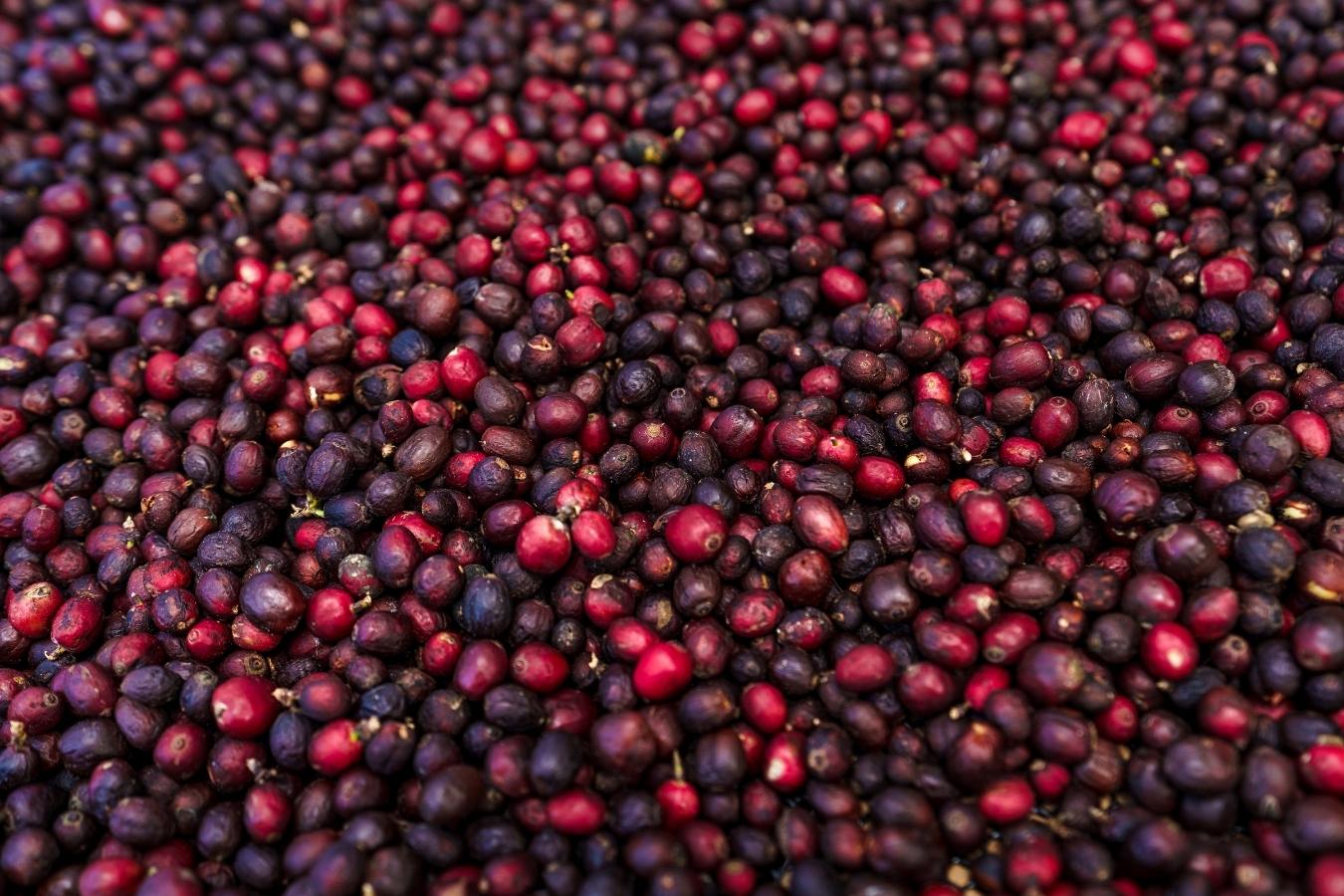
Because of the above disadvantages, people rarely process this method, especially for high-class coffee like Arabica.
However, if dry processing is done correctly: high ripeness rate, drying on rigs, right time and temperature, avoiding mold, the coffee can taste better than other processing methods.
Wet processing
This pre-processing method is used to ensure the best quality for high-quality coffees. The making process will take more effort, but the value of the finished coffee will be much higher.
Immediately after being harvested (collecting only ripe seeds, the number of green beans must be limited to the maximum), people will bring the coffee cherries to grind. Then put it through the water to treat, filter out the dense outer layer and then get the rest of the filling to incubate to ferment. Fermentation is only completed when the husk becomes rough and clear of viscous.
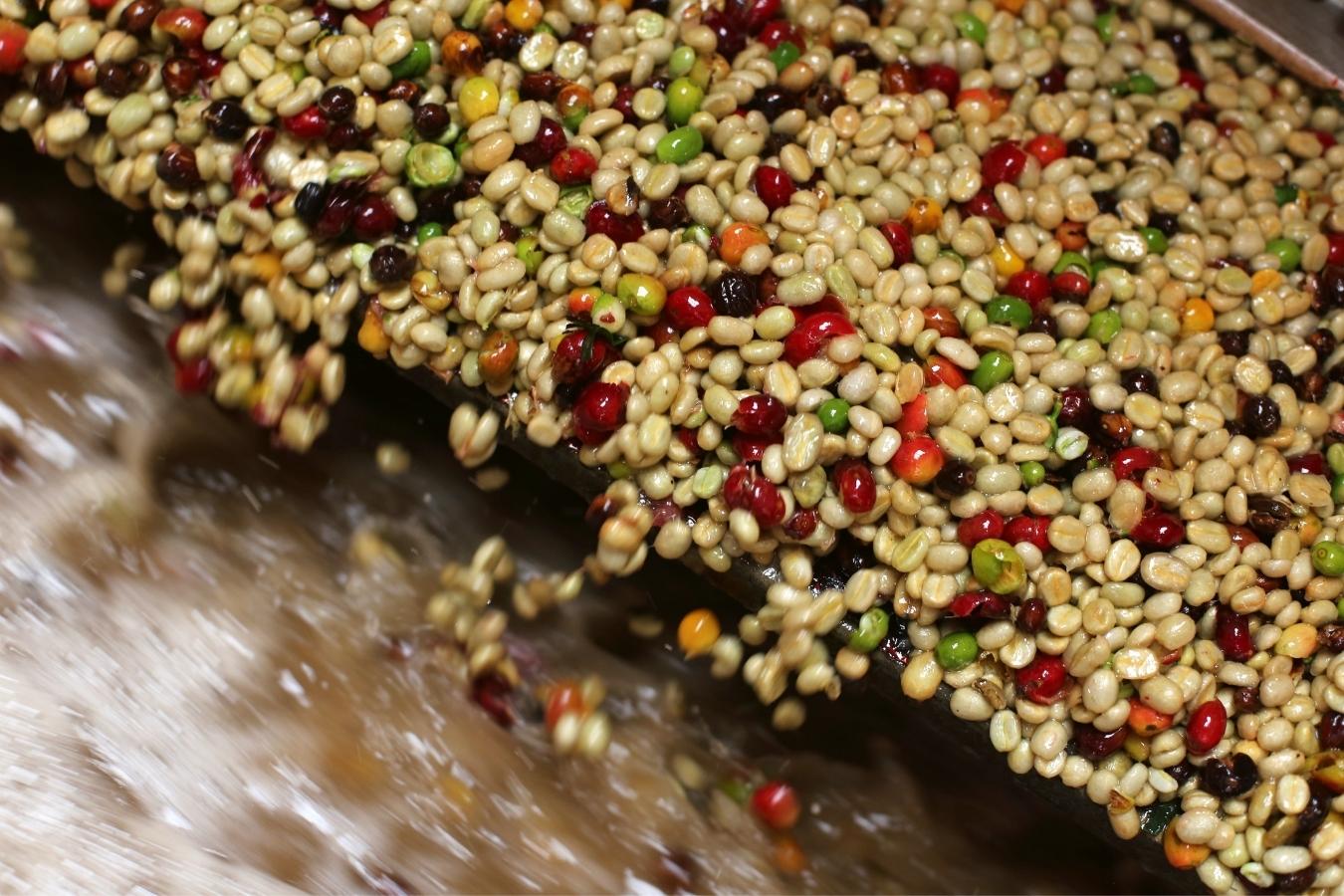
Finally, the coffee beans will be washed and dried, then removed from the outer husk to produce the finished beans.
The drying process is also very elaborate, do not dry it directly on the ground because it will absorb moisture. When drying, it is necessary to spread evenly so that all seeds are evenly dried; the drying ends when the roots are not broken. This requires a lot of experience from the farmer.
Coffee prepared by the wet method will taste clean, balanced, and light in texture.
Honey processing
This cooking method is also quite similar to wet processing. However, people will not remove or retain all slimes before drying. This will give the coffee bean a dark brown color similar to honey, true to the name of the honey processing method.
Coffees processed in this way will retain quite a bit of sweetness and increase the flavor when enjoyed.
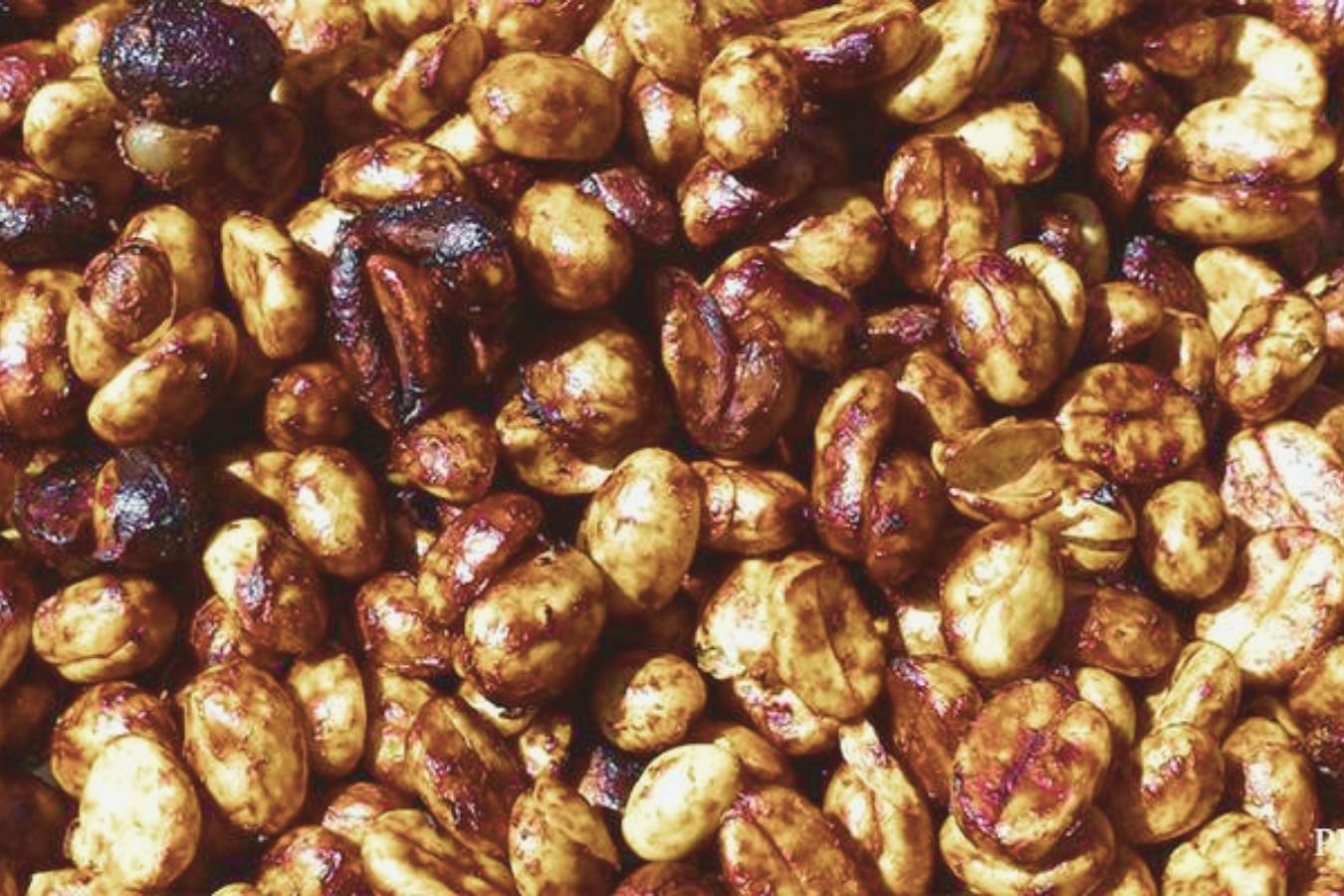
The Honey processing method gives a rich taste, sweetness, smooth texture, tartness, and ripe fruit.
11. Coffee Roasting
Why roast coffee?
The roasting process will affect the chemical components in coffee, especially caffeine, lipids, and proteins, to transform them, creating a characteristic aroma and taste when drinking.

The process of transforming coffee beans during the roasting
Coffee roasting will start from the moment the temperature reaches 100 degrees Celsius until it ends at 240 degrees Celsius. During this heating process, the ingredients in the coffee will begin to change:

When reaching 100 degrees C
The amount of water inside will evaporate, causing the coffee bean to shrink.
From 0 – 150 degrees C
The amount of water continues to lose; the coffee bean begins to change color to light yellow. The shrinking process continues, and the aroma starts to rise with it.
From 150 – 180 degrees C
If the temperature is kept at 150 degrees Celsius, the coffee bean will turn from light yellow to light brown. It is necessary to heat up to 180 degrees C to make the coffee smell more fragrant. The shrinking process ends, replaced by volumetric expansion due to the internal components.
From 180 – 200 degrees C
During the heating process from 180 to 200 degrees Celsius, the coffee beans have expanded to their fullest extent, the aroma is fragrant, and the ingredients inside can be easily ground.
From 200 – 210 degrees Celsius
Coffee beans begin to expand to the point of explosion, and smoke begins to rise to create a fragrant aroma and spread further.
From 210 – 230 degrees C
Coffee beans continue to swell due to the release of carbon dioxide and more explosions.
From 230 – 240 degrees C
The seeds will now have a dark brown color and a strong scent, and the ingredients inside will also be modified to achieve the best flavor. This is the best time to puree and start mixing.
Note that the coffee roasting process is the healing process for the beans. The temperature above is the accumulated temperature inside the coffee beans. Depending on the purpose of roasting and the preparation method, roasters can choose at what temperature to stop the roasting process.
Or, if the roasting is done on a roasting machine that displays a graph of heat over time, the roaster can also end the roasting process by time, depending on the purpose of preparation.

12. Coffee Products
Nowadays, there are many different ways of processing coffee, so there are many kinds of finished products. Each type has its advantages.
Pure roasted coffee
This type of coffee is roasted and ground into powder. This is a coffee made from 100% natural coffee beans, without the shadow of any other additives such as beans, corn, or grains. The advantage of pure coffee is to keep what is most characteristic of coffee, connoisseurs, and lovers of this bean will love to use pure roasted coffee.

Instant coffee
Realizing that powdered coffee takes a long time to prepare, manufacturers have begun to think of ways to help users enjoy coffee more conveniently. They premixed the coffee powder with flavorings and additives during the production process to achieve the desired taste. Users just need to bring this powder to boiling water, mix it up, and can enjoy it; it only takes 30 seconds to make a cup of coffee.

It can be seen that the advantage of instant coffee is its quickness, the flavor has been prepared and calculated with a moderate amount, so you can always enjoy the best cup of coffee.
However, it has a rather significant disadvantage that the flavors mixed inside will lose some of the pure coffee taste.
Coffee beverage
If even making instant coffee takes up your time or you don’t have the conditions to make it, a ready-to-drink cup of coffee will be highly convenient. Coffee water is similar to instant coffee but has been prepared, just open the lid to drink. The advantage of this type of coffee is its quickness and convenience.
13. Coffee Brewing Methods In The World
Coffee is the most popular drink in the world. However, not everywhere do people mix in the same way, but depending on the country’s characteristics and taste, they have their way of socializing. Some famous recipes can be mentioned, such as:
Italian Espresso, Cappuccino, and Latte
These can be said to be the most popular drinks in the world. Espresso uses the finest coffees, with a smooth consistency and great color. Mixing Espresso with milk according to specific standards will create Capuchino and Latte.

Buna Coffee in Ethiopia
In the homeland of coffee, people are very proud of this drink because every coffee originates from a goat herder in their country. So the way to enjoy coffee here is also somewhat different. Ethiopians will use coffee (locally Buma) mixed with salt or butter, not sugar and milk like other countries.
Turk Kahvesi of Turkey
This recipe is straightforward; people just need to put the coffee powder in water and boil it on the stove until it has enough flavor.
Danish Kaffe
The Danes will use pure coffee for drinking with cream or fresh milk without any impurities. This way of making coffee is quite similar to Italian cream coffee.
Ireland of Ireland
This is a uniquely Irish way of making coffee. They’ll put some Irish Whiskey, sugar, and a little frosting in the hot coffee. This drink is very suitable to warm people for the cold winter nights here.
The most special is Vietnam’s coffee filter: This is the most popular preparation in Vietnam. Almost every home has a filter to make its coffee, and outside of restaurants, the image of a coffee filter has been imprinted on many people’s subconscious.
14. Enjoy Coffee
Coffee flavor
The taste of coffee is something complicated to say, and it is based on the perception of many people. Each type of coffee has its unique flavor and, depending on each person’s preferences, makes their choice.
- Arabica has a beautiful brown color, smooth and smooth. When enjoying, a cup of fine Arabica will have a characteristic mild bitter taste, seductive aroma, plus a little sour or fruity taste.

- Robusta is bitter, not sour like Arabica.
We can also combine Arabica and Robusta in specific proportions to make the coffee taste better.
Benefits of coffee
In coffee, there is a lot of caffeine, a substance that has many effects on the body. At the same time, beneficial minerals and compounds also give regular coffee drinkers many benefits.
Talking about the beneficial effects of coffee, one can list categories such as Anti-drowsy, refreshing, more comfortable, preventing cancer, aging, prolonging life, beauty, and weight loss… And many other benefits.
However, the above benefits are only obtained when drinking a moderate amount, averaging 2 cups of coffee a day. If too much coffee is used, it can also cause users to lose sleep, get drunk, hallucinate, become addicted to coffee, increase blood pressure, etc.
15. Preserving Coffee
Powdered coffee can be stored for up to 1 year from roasting and grinding if done correctly. Especially within 14 days after crushing, it should be put in an airtight container, in a dry place, away from moisture to avoid losing caffeine and flavor.
You should not put it in plastic bags if you roast your coffee because it is easy to get moldy. Instead, you can store coffee in bags with one-way valves or vacuum. This is a good way of preserving because outside air cannot get in.
16. Conclude About Coffee Basics Overview
Knowledge about coffee is quite a lot. To fully understand and this drink from planting, harvesting, roasting, preparing, preserving, you need to have a long time to learn. However, with the above general knowledge of Helena Coffee Vietnam, hopefully, you can understand more about them. When enjoying coffee, feel the quintessence of the sun, the wind, and the sweat of those who have worked hard to make it.
—
HELENA COFFEE VIETNAM | VIETNAMESE COFFEE PROCESSING & EXPORT
Helena Coffee Processing & Export in Vietnam | Helena., JSC, founded in 2016, is a Vietnamese coffee exporter. After years of expansion, we have become one of the most renowned coffee production and export companies in Vietnam. Our products are currently shipped to and consumed in a number of nations and regions throughout the globe, including Europe, North America, Asia – Pacific, Middle East,…
Contact us:
- Address: 124 Ngo Quyen, Tan Loi Ward, Buon Ma Thuot City, Daklak, Vietnam.
- Phone/Whatsapp/Line/ Telegram/Viber: +84.789.818.828 (Mr. Edison)
- Email: helenacoffeevn.jsc@gmail.com
- Website: https://helenacoffee.vn/
- Fanpage: https://www.facebook.com/HelenaJSC